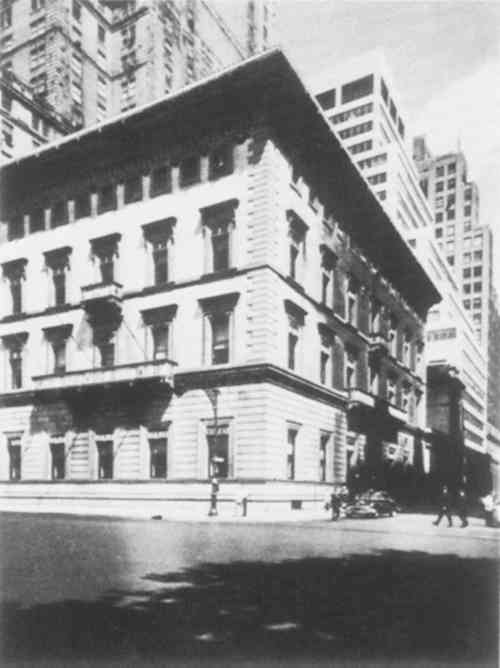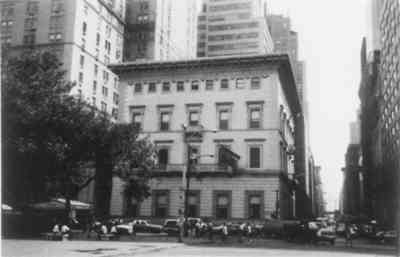CLEANING, IRON STAIN REMOVAL, AND SURFACE REPAIR OF ARCHITECTURAL MARBLE AND CRYSTALLINE LIMESTONE: THE METROPOLITAN CLUBFRANK G. MATERO, & ALBERTO A. TAGLE
3 THE STONEDespite the massive and imposing appearance of the building's ashlar walls, what appears to be a tour de force of traditional load-bearing masonry is actually a 4 in. stone veneer attached to an internal steel frame with brick backing, construction typical for the period. The selection of a fine, smooth rubbed Vermont white marble in combination with the coarse, tooled crystalline limestones of New York and Maryland would have provided a subtle yet elegant contrast in color and texture (see fig. 1). However, the partly random combination of different crystalline limestones7 and the use of inferior stone due to construction delays caused serious problems of discoloration and staining that quickly obliterated the original tonal effect.8 Selection of these individual stones and their combination was not unusual given their widespread use and popularity among American architects and builders at that time. The crystalline limestones of Westchester County, New York, and northern Maryland had a long tradition of commerical architectural use since the early 19th century due to their reported hardness, whiteness, and availability in large blocks free from faults and jointing (Urquhart 1986). The Vermont marble quarries, although also commercially exploited during the latter half of the 19th century, were not as popular due to limited accessibility. However, by the end of the century, improved shipping routes and increased promotion of the wide variety of fine white and colored marbles available made the Vermont quarries one of the largest domestic marble suppliers in the country. The Rutland white marble used for the upper ashlar walls at the Metropolitan Club enjoyed a well-deserved reputation for its nearly blemish-free fine-textured appearance and was a popular choice and competitor with imported Italian statuary marble. The Maryland and Tuckahoe stones, on the other hand, are both crystalline dolomitic limestones–not true marble due to their incomplete metamorphosis–composed of a large percentage of dolomite in addition to calcite. They are both distinctive in their unusually large grain size and the occurrence of the secondary silicate minerals tremolite and phlogopite. The former often appears on the surface after weathering as pronounced dark crystalline inclusions, and the latter appears as irregular tawny micaceous bands. The stone also contains a small percentage of ferruginous accessory minerals: hematite and pyrite, which on exposure and weathering impart a brassy yellow or streaky orange-brown color to the stone. This weathering phenomenon, reported in the geological literature for both stones, had been noted in particular for the Tuckahoe stone at least 10 years earlier in New York City, in 1879 (Julien 1884). Despite these observations, both stones enjoyed widespread use, no doubt for their initial dazzling white appearance, availability in large blocks, and close proximity and easy removal and transport to the major East Coast cities. McKim, Mead, and White had in fact used the Tuckahoe stone for many other projects, including the Century Club and the Washington Square Arch, both in New York City. Yet by 1900, only 16 years after the completion of the building, a rustlike discoloration of the Metropolitan Club's stone was reported, especially on the base, confirming the warnings of earlier observations. Despite proposals for mechanical and chemical cleaning at this early date, the condition went untreated until 1931, when the architects again noted the worsening discoloration of the stone and suggested that the building be cleaned. Apparently, nothing further was done to the exterior (fig. 2) until 1965, when the building was reportedly steam cleaned and painted. Painting became the preferred method of cosmetic treatment during the next 20 years, imparting a dead pallor of drab gray and concealing the dazzling, albeit marred, whiteness of the stone (fig. 3).
|

